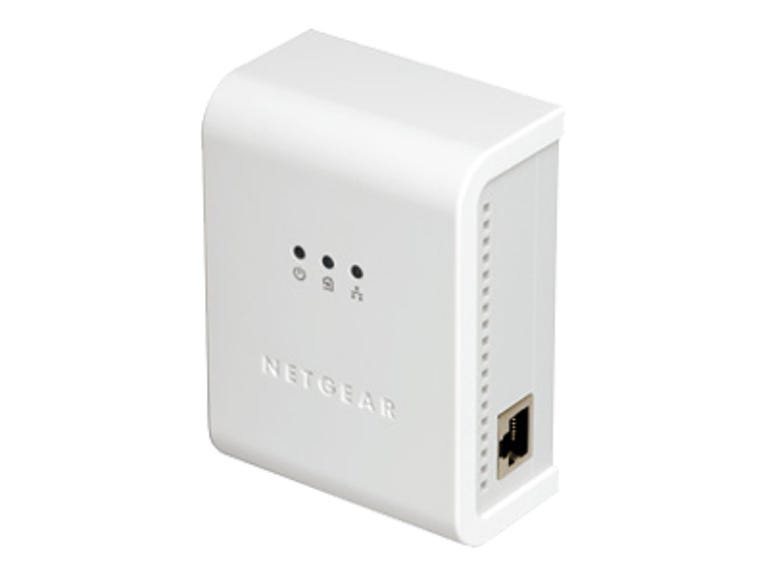 Why You Can Trust CNET
Why You Can Trust CNET Netgear Powerline HD review: Netgear Powerline HD
Simple to set up and able to provide ample throughput, Netgear's Powerline HD Ethernet Adapters are a great solution for anyone who wants the benefits of home networking but doesn't want to rewire the entire house or mess with Wi-Fi. Be forewarned, though: it's not an inexpensive solution.
If you're Wi-Fi shy but don't want to give up on the idea of streaming content around your house, check out the Netgear Powerline HD Ethernet Adapter. It's simple to use, and the throughput is high enough to stream high-definition video without a glitch. The downside is that the adapters aren't cheap: each one will run you about $100. And despite the fact that you don't have to run Ethernet cable through your house, as you would with a regular wired home network, you'll still have to deal with a potential rat's nest of wires around each adapter. Still, you'll save on the expense of rewiring your house for Ethernet. And the Netgear adapters are faster and cheaper than the similar Panasonic HD PLC Ethernet adapters.
The Good
The Bad
The Bottom Line
Power-line technology uses a building's existing electrical wiring to convey digital data. The wiring serves as the network, and each electrical outlet serves as a node. The electrical current won't interfere with your data network because electricity and data are transmitted at very different frequencies. The setup of every home power-line network is very similar: connect the first adapter to your router and an outlet, then plug in each additional power-line adapter anywhere you want connectivity and connect a client to that adapter via Ethernet cabling. Voilà, you have a power-line network. Obviously, you'll need at least two adapters to create a network, and Netgear sells a starter kit that contains exactly that: two adapters and two 6-foot Ethernet cables. Though the inclusion of the cables seems like a no-brainer, Panasonic doesn't include them with its power-line adapters, so kudos to Netgear.
Netgear's Powerline adapters are glossy white bricks with nothing but electrical prongs jutting out the back, an Ethernet port on the side, and three tiny LEDs on the front. Unlike the Panasonic adapters, the Netgear brick plugs straight into a wall outlet, with no additional power cord. While we like the tidiness of this solution, it could potentially interfere with other large wall warts (that is, power bricks) you have in the outlet. And you can't plug the adapter into a power strip or an extension cord, either, because those devices may actually strip the data from the electrical wires.
Setting up a power-line network with the Netgear kit couldn't be simpler: connect the adapter to one of your router's LAN ports via Ethernet cable and plug in that adapter. Take the second adapter anywhere in your home and plug it into an outlet. It may take up to 30 seconds for the adapters to establish contact. Then, using another Ethernet cable, connect a client device to the second adapter. You don't have to register each "slave" adapter to the "master" as you do with the Panasonic power-line adapters; they'll configure themselves automatically. Nor do you need an adapter for each device you want to network: you can connect a switch to a power-line adapter and connect as many devices to the switch as it will support. For example, a single adapter and switch in your living room could support a DVR, a media adapter, a set-top box, and a notebook PC. Unfortunately, you will still have to contend with an unsightly tangle of cords and cables. Netgear recommends a maximum of 16 adapters per network.
The included CD has an installation and management utility that you can use to monitor your network, change the network ID, and search your network for registered and unregistered adapters. You can also use the utility to give priority to certain types of network traffic, such as multimedia files or voice packets for your VoIP phone.
Security isn't as much of an issue on a power-line network as it is on a Wi-Fi network. After all, there's no data flying through the air to be intercepted. Still, you should take precautions, especially if you live in a multi-unit building. For one thing, you can change your network's name from the default name that Netgear provides. Any adapter (and client) that attempts to join the network will have to know its name. You can also set a password on your network to keep out would-be intruders.
In our Labs' tests, the Netgear Powerline HD Ethernet Adapters clocked an impressive 52.7Mbps throughput rate--faster than that of the Panasonic adapters, which posted a 35.4Mbps rate. While 52.7Mbps is well off the theoretical maximum of 200Mbps, it's still more than enough for standard home-use tasks, such as Web surfing. And according to CNET's home video experts, this rate will more than suffice for transmitting high-def content.
Netgear backs the Powerline HD Ethernet Adapters with a one-year warranty. Toll-free phone support for basic setup issues is free for the first 90 days. More-detailed assistance can be had for a price: a hefty $32.95 per incident (up to 30 minutes). If that seems steep, start with Netgear's site, which has FAQs, a troubleshooter, and downloadable installation and user guides. The included CD has a user guide for reference, too.

